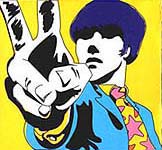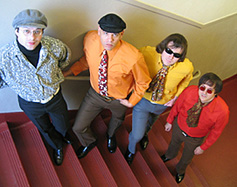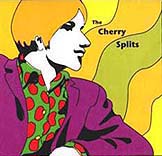|
APRIL 2005 ISSUE
Interview with Ron Burns and Matt Kiesner (4-8-05)
Intro:
Playing vintage equipment and writing their own material, The Cherry Splits perfectly capture the psychedelic/garage band rock of the mid-'60s. I talked to the founders of the band, Ron Burns and Matt Kiesner about their music and their motivation for keeping this genre of music alive.
E.C.: I hear a mixture of psychedelic, "bubblegum" and "Nuggets"-styled garage rock when I hear The Cherry Splits, both live and on CD. What was your original concept for the band? Ron: To do just that, exactly, with both originals and (mostly) very rare covers, and to emulate the look and sound of the era with pop-art graphic design, mod fashion and with vintage instruments and psychedelic lighting effects. E.C.: What are your musical backgrounds? What type of music did you play before? Ron: Matt has always been strictly a 60's purist, but I've played in a Chicago blues band, a rockabilly band, a British Invasion blues band, an electric folk rock band, a 70's hard rock band, a 70's funk band, an 80's techno-pop band and a 90's indie-rock band. Matt: I taught myself guitar in order to play 60s garage music and keep it alive. I consider myself a specialist in 60s music and it’s all I’ve wanted to do. My first real band was Thee Intellectuals back in college at UC Santa Barbara. We played angry four-chord garage punk with a lot of piss and vinegar. I wasn’t getting laid a lot so that contributed to the sound. After college I moved to San Francisco and co-founded The Nederbeats that specialized in Dutch Beat. We were all covers but it taught me a lot about harmony and song structure that really helped me grew musically. Then I left SF for ATL and after floating through some unsuccessful musical projects, I ended up here. E.C.: How did the "Cherry Splits" name come about? When I first talked to Matt last year, the name was "Peppermint Fizz". Why the change? It’s funny, but to me "Cherry Splits" sounds more "bubblegum", while "Peppermint Fizz" sounds more psychedelic. Where you leaning towards the "bubblegum" end of music - is that the reason for the name? Ron: We felt “Peppermint Fizz” was too much of a mouthful. It didn't roll off the tongue. But we liked the image of red and white swirls and the design possibilities with that, as well as the candy connotation. Matt had a red guitar and I had red drums. So I was thinking of other red candy flavors; I liked cherry, thought of the Banana Splits (one of our musical influences), put the two together and came up with the name. Matt: The name change was Ron’s Idea. I wanted to call the band ”The Fruit Orchard” -it’s the perfect goofy innocent 60s band name. Our first record could be called “It’s harvest time at…” but Ron thought it wasn’t macho enough, ha ha! E.C.: I like your emphasis on vintage instruments like the electric sitar. Do you play chords on it like a guitar, or just single notes? What is the tuning? Also, what is that theramin-like instrument that you play on "Dronovan"? Matt: I usually play single notes on the electric sitar. The tuning is standard guitar but it can get a bit brash with chords. Also with the buzzing you have to strum slow, and we don’t really do any really mellow material. As for “Dronovan” on our CD, that was a one take flurry of creativity. The droning “theremin” sound is actually a lap steel played with an Ebow with echo added. E.C.: When it comes to the image of the band you all wear '60s period gear. Is this part of the overall concept of the band, the recreate that period in time visually? Ron: Yes. Matt is the 60's style expert. Matt: I guess I am. Well before this band I was collecting 60s clothes, records and anything else I could find. My daily wear is a slightly toned down version of my stage appearance. For me, the psychedelic mod aesthetic is part of my identity and the band is another expression of that. E.C.: I got to hear some of your early demos last year and its great to hear the songs fully realized on CD. Since you two (Ron & Matt) are the main songwriters, how do you decide who sings on what song? I mean, Ron has a really deep voice (even deeper than Eric Burdon!). Is the person who sings the main songwriter on that song? Ron: I think Matt has the deeper voice! (That's Matt on "Masie Mae".) Matt: Yeah my range is bass/baritone. Ron: Usually, the main songwriter sings lead, unless the other's voice better suits the song. I wouldn't really say Matt and I are competitive songwriters, although we do inspire each other to keep up with the amount of writing we do. But we seem to collaborate well. The communication between us is very open. If one of us doesn't like something, or wants to change something the other has written, we're both perfectly okay with that. E.C.: How do you write such authentic sounding songs? Do you have any particular bands or songs in mind when you set out to write a song? Also, are the songs true collaborations between Ron & Matt? Matt: For me it’s pretty easy since 60s music is all I listen to. That may sound strange, but it’s true. And since I learned to play guitar and keyboards from listening to 60s records it’s all I know how to play. I will usually have some sort of idea of what kind of 60s sound I wanted. “Masie Mae” is bubblegum soul, ala Banana Splits. “Shakedown Shelia” is a tribute to Tommy Roe. Paisley Fields started as a psychedelic retelling of the Cowsills’ Indian Lake, but it ended up something much more hard edge. “Hard and Heavy (with Marshmallow)” is named after the Raiders album, but doesn’t really sound like them. Instead, I wanted to indulge in the schizophrenia of that title. Admittedly a lot of the influences are very obscure, but I’m definitely aware of them when I’m writing. Ron: Thanks for the compliment. Some are true collaborations, such as “Hard & Heavy (With Marshmallow)”, “Katie Come On” and “Dronovan”. Others are composed primarily by one or the other. Matt is a far better guitar and keyboard player than I am. My solo compositions tend to be pretty simple musically. My strengths are coming up with unique rhythms and lyric writing.
E.C.: The artwork on your website, CD cover and band flyers really sets that '60s mood. It is a very Peter Max kind of art. Did one of the band members do this art - or is it vintage '60s art? Ron: Matt digs up a lot of the ideas from extremely rare vintage 60's art. I take the ideas and redraw them on the computer, modifying them to meet our needs. Matt: There is a source to all our artwork from the 60s, but it’s a secret. Hee hee! E.C.: What is the appeal of classic psychedelic/garage rock to you? Or do you just find contemporary rock music stale? Ron: For me, it's the state of mind. I like the utopian ideal of 60's psychedelia. Music can take you to another, a better place, as it should. Entertainment can allow for escapism. It should be fun. Contemporary rock music is definitely not fun for me. The mood is either enraged or self-pitying. It's the aural equivalent of reality TV, always wallowing in the seamier side of life. The 60's were a more colorful and a more hopeful time. Matt: I got into 60s garage via the Cramps who I got into due to their connection to cult movies (another passion of mine). I was a big Cramps fan and then I stumbled across Pebbles 1 and its been one big slide since them. I find 60s music endless inventive. Almost everything that became popular later has strong roots in the 60s, from punk to heavy metal, to new wave and electronica. The period from ‘66 to ‘68 was an era of remarkable creativity that I believe has never been topped. E.C.: When and where did you record the CD? How long did it take? Ron: We recorded the whole thing on my Apple computer at my house, and then took the masters to Zero Return studio in Atlanta to lay down real drum tracks. All in all, from writing the songs to the final mix, I'm guessing it took about six months - does that sound about right, Matt? Matt: Six months on and off. E.C.: Did you have any tunes leftover from your first CD? When can we expect another CD? Ron: We only left two or three songs off the first album, but Matt has a backlog of new material. We may start on another CD by the end of this year. E.C.: I like that you place an emphasis on your originals, maybe playing a few classic covers. It really says something for the strength of the songs that they sound so authentic. Is your live show the emphasis over recording? Ron: Right now it is, but it wasn't while we were recording, and I expect it won't be when we're recording again. Matt: Coming from San Francisco, a lot of bands over there take no care in their recordings, creating no-fi records that you have to struggle to listen to. It all started with The Mummies and Supercharger and bands still believe lo-fi is the gospel. Personally, I think all that was novelty and that those records sound dated and stale now. I think that unlike a live show, which is fleeting, a record is an eternal document of a band and that band should try to make something worth listening well after the band ceases to exist. The plan with future recordings is to go in a more grandiose direction and be more adventurous sonically. E.C.: The concept of the monthly gig at the “Mystery Spot” is so cool! The way the place is set up, you really have that feel of a classic Sunset Strip club of the ‘60s. Is this something that The Cherry Splits intend to do every month? Ron: For the time being, yes. We originally intended to do one the first Saturday of every month, improving on and adding more art and decor to each one. But we've already had to make an exception for June, because we'll be in Chicago playing the Mod Chicago festival June 3rd. (We may push it back to the 2nd Saturday in June, or we may skip June and start over in July; we haven't decided yet.) The idea was to be able to use The Mystery Spot as our main venue, because unlike clubs, it's an environment we can control - the admission, the atmosphere, the scheduling, the sound, the booking, everything. We want to provide a groovy place for like-minded individuals to come each month and celebrate the spirit of the 60's with us.

EAR CANDY:
|

 Right: some of the groovy art that adorns the CD - check out
Right: some of the groovy art that adorns the CD - check out